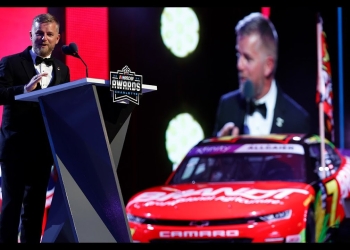The Big One at Talladega: Analyzing the Chaos
The Talladega Superspeedway is known for its high-speed racing and unpredictable moments. Recently, fans witnessed one of the most dramatic incidents of the season - the "Big One" that involved over 20 cars. Let's dive into the data and break down what led to this massive crash.
Setting the Stage
As the race entered its closing laps, tensions were high. Every driver was gunning for the win, creating a pressure cooker situation on the track. Two powerful lanes of cars were pushing hard, creating a precarious balance of speed and control.
"Everybody's wide open. You've got two really powerful lanes pushing really hard," noted one race analyst.
The Catalyst: Car #38
The situation became even more complex when the 38 car, running about 10th or 11th, entered the mix as a lapped car. This forced the field to navigate around it while maintaining their aggressive racing lines.
Key Factors Leading to the Crash:
- Two compressed lanes of cars
- Lapped traffic (Car #38) disrupting the flow
- Limited visibility for lead cars
- Varying speeds due to drafting effects
The Breaking Point
As the pack reached the backstretch, the disruption caused by Car #38 began to have a ripple effect. The inside lane snaked around the lapped car, while the outside lane descended into what one observer described as "chaos."
"It looks like chaos. They're just wherever there could be, there's a car," commented a race analyst.
This disorder led to speed differentials throughout the pack. Some cars slowed, while others gained speed due to the draft. The situation reached a critical point when Brad Keselowski got a huge run on Austin Cindric entering Turn 3.
Click here to preview your posts with PRO themes ››
The Aftermath
The resulting crash was devastating, with over 23 cars involved. Many were left with flat tires, unable to move under their own power.
| Impact of the Crash |
|---|
| 23+ cars involved |
| Multiple flat tires |
| Cars unable to steer or brake |
| Significant damage to numerous vehicles |
The Hidden Challenge: Aluminum Pucks
An often-overlooked aspect of these crashes is the role of the aluminum pucks under the cars. When all four tires go flat, the cars essentially ride on five aluminum discs about twice the size of hockey pucks.
"When they slide and all four tires go flat, they're actually riding on five aluminum pucks under the race car," explained an insider.
This makes the cars incredibly difficult to control, as drivers can't steer, brake, or accelerate effectively.
NASCAR's Response
The massive pileup presented a significant challenge for NASCAR officials and team crews. They had to:
- Assess the damage to each car
- Determine which cars could be safely driven back to pit road
- Organize the removal of severely damaged vehicles
- Balance the need for safety with the desire to restart the race quickly
The situation also highlighted potential issues with NASCAR's Damaged Vehicle Policy (DVP), which aims to keep heavily damaged cars off the track to prevent further incidents and reduce costs for team owners.
Looking Ahead
This "Big One" at Talladega serves as a reminder of the inherent risks in superspeedway racing. It also raises questions about how to balance the excitement of pack racing with driver safety and fair competition.
As NASCAR continues to evaluate its policies and procedures, fans and drivers alike will be watching closely to see how future races at tracks like Talladega might be affected.
Click here to preview your posts with PRO themes ››
In the end, the Talladega incident showcases the split-second decisions and complex factors that make NASCAR racing both thrilling and challenging. It's a stark reminder of the fine line between controlled chaos and catastrophe in motorsports.









